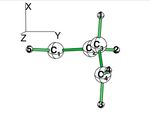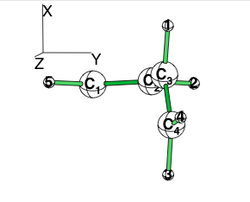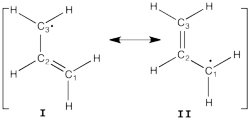<<< VB tutorials main page
BLW method & HuLiS program
| BLW within GAMESS (Version: MAR-25-2010 R2)
|
|
BLW is provided by Yirong Mo (Western Michigan University - USA). It allows to optimize local wave functions. DFT approaches allow to include a part of correlation into the structure.
Gradients are available for geometry optimization. Structures can interact with $BLWCI group.
During the workshop, a BLW computation of file.inp is obtained with the command "blwrun file "
file.log and file.blw are in the current directory.
BLW help
|
| HuLiS : a Huckel-based code
|
|
HuLiS is provided by Stephane Humbel (Aix-Marseille Université - France).
This is a graphical java applet that deals with Huckel and Lewis structures. It computes coefficients and weights of mesomeric structures through two different approaches: the energy related approach is a simulated CI (HL-CI - deprecated); the wave function approach is a projection of Lewis structures onto a Huckel derived wave function(HLP). This second approach is more reliable.
HuLiS is launch with the command "java -jar ~/bin/hulis.jar" or via the web site HuLiS
Details of the principles are written at
HL-CI and HLP explanations.
Seminal papers are HL-CI and HLP.
|
| Main exercises
|
Exercice 1 (Lewis structures of benzene, resonance)
| Topic
|
|
The benzene molecule is commonly represented as the resonance between the two Kékulé structures. The aim of the exercise is to understand the relative importance of the different Lewis structures in the benzene molecule using BLW and HuLis.
According to IUPAC’s Goldbook, resonance energy is defined as “The difference in potential energy between the actual molecular entity and the contributing structure of lowest potential energy”. However this definition does not precise what is the geometry of the contributing structure of lowest potential energy. Consequently, we can define two types of resonance energy: the vertical resonance energy (VRE) and the adiabatic resonance energy (ARE). This exercice tutorial will guide us toward Lewis structures and resonance of benzene.
|
The 6-31G(d) basis set will be used in the following.
1/ Vertical Resonance Energy - at the geometry of benzene.
With the BLW program, and using the provided optimized geometry of benzene molecule, define one 1,3,5-cyclohexadiene Lewis structure, and optimize it's orbitals. 4 blocks need to be defined : 3 blocks for 3 pi bond, and 1 for all the sigma electrons.
Using benzene energy, calculate the Vertical Resonance Energy (VRE).
2/ Adiabatic Resonance Energy (ARE)- relax the Lewis structure geometry
With the BLW program, relax the Lewis' structure geometry.
- Compare the C-C bond distances to benzene's. Ensure that it is consistent with the Lewis structure.
- Compute the Adiabatic Resonance Energy (ARE) and comment.
- Compare the resonance energies computed by the BLW method to the conventional experimental resonance energy based on the hydrogenation heats of benzene and cyclohexene (36 kcal/mol).
3/ With HuLiS, evaluate the space spanned by Lewis structures compared to that of delocalized wave functions.
- Draw the benzene with the Huckel tools (blue, left) and create two Kekules structures with the Lewis tools. Double bonds are obtained by clicking a single bond - A second click returns to the Single bond.
- Note the low value of the trust factor <math>{\tau}</math>.
- Add to the wave function the 3 covalent Dewar structures.
- How does <math>{\tau}</math> vary?
- Remove all structures [Erase Mesomery] and automatically generate all possible structures having one charge separation:
- <mode><expert mode> [Generate all]
- Note the value of <math>{\tau}</math>, and the weight of all Lewis structures needed ([Results]).
FILES FOR BENZENE
Exercice 2 (allyl)
- 1/ With the BLW code calculate the relative energies of the three Lewis structures of the allyl cation at the HF level. By comparison with the energy of the allyl cation, determine the VRE and the ARE. Compare the C-C bond distances.
| Hints
|
- Starting from the delocalized geometry, the first iteration of the optimization of the localized structure will give the VRE.
|
- 2/ Repeat the first question at the B3LYP level.
- 3/ Repeat questions 1 and 2 for the allyl radical.
FILES FOR THE ALLYLS
Exercise 3 (BH3... NH3) electronics at the B3LYP 6-31G(d) level
BLW energy decomposition analysis can be used to shed light into the nature of intermolecular interactions. Example of NH3∙∙∙BH3. Visualize the polarization and electron transfer effects using the electron density difference (EDD) maps.
| Geometry
|
|
the geometry of the complex we use is
$DATA
BLW-ED Analysis
C1
N 7.0 0.000000 0.000000 0.728869
H 1.0 0.000000 0.951707 1.095972
H 1.0 0.824202 -0.475853 1.095972
H 1.0 -0.824202 -0.475853 1.095972
B 5.0 0.000000 0.000000 -0.934793
H 1.0 0.000000 -1.170908 -1.238679
H 1.0 -1.014036 0.585454 -1.238679
H 1.0 1.014036 0.585454 -1.238679
$END
|
- 1/ Make orbitals of BH3 alone (then NH3) in the geometry of the complex
- 2/ Let fragment orbitals to polarize in the full complex.
- 3/ Let delocalize. This is just a standard DFT calculation.
| Preliminary Remarks :
|
|
B3LYP calculation in Gamess is specified in $CONTRL :
$CONTRL SCFTYP=RHF DFTTYP=B3LYP runtyp=energy maxit=200 icharg=0 $END
And 6-31G(d) basis set is requested with
$BASIS GBASIS=N31 NGAUSS=6 NDFUNC=1 $END
|
| Step by step help :
|
- 1/ Perform a NH3 BLW calculation of the fragment alone in the geometry of the complex with $BLW NBLOCK=1 $END and keep the generated .blw file for next step (same for BH3).
- We obtain
- nh3.log: FINAL R-B3LYP ENERGY IS -56.5111505350
- bh3.log: FINAL R-B3LYP ENERGY IS -26.5644674370
= > summ = -83.07561797
- 2/ Do the complex in a NBLOCK=2 BLW calculation and see the energetic effect of the polarization of each fragment. The initial orbitals are obtained from .blw files of individual fragments
---ORBITALS (LOCAL BFS)--- part, and copied after the $BLWDAT fragments definition. A blank line separate each fragments’guess.
At this stage, we can want to do the calculation at full accuracy from the very first step. The following line avoid initial SCF cycles (SWOFF=0.0), and initial coarse grid DFT steps :
$DFT SWOFF=0.0 NRAD0=96 NLEB0=302 NTHE0=12 NPHI0=24 $END
- We obtain
- ITER 1 E(RBLW) = -83.059219
- FINAL R-B3LYP ENERGY IS -83.093218 compared to the 1st iteration it is -21.3 kcal/mol= electronic relaxation
- 3/ Let the delocalization of all electrons. (NBLOCK=1 + read localized guess orbitals OR standard B3LYP calculation)
- We obtain
- FINAL R-B3LYP ENERGY IS -83.148013 -34.4 kcal/mol charge transfer.
Remark0 : BSSE can be computed with CP approach and use to correct this energy. A ghost atom is noted with a negative Z (e.g. a ghost Carbone in noted as C -6.0 X Y Z instead of C 6.0 X Y Z).
Remark : the electronic differential density can be mapped using BLW and DELOCALIZED cube files generate with gaussian for instance. An utility (edd) substracts the two densities from the cube files named test.cube_BLW and test.cube_HF and stores it in the file test.cub. The new cube file can be visualized with gaussview (gview).
to generate the cube file for BLW orbitals, use Gaussian (gaurun) with this route card
#B3LYP/6-31G(d) 6D Nosymm Guess=(Cards,only) Cube=(81,Density,Full)
and after the geometry specification,
input the orbitals from the BLW file as cards,
don't forget to name the cube file.
test.cube_BLW
see also gaussiancube file
|
FILES FOR THE NH3 ... BH3
|
| Optional exercises - homework
|
Exercise 4 (Butadiene deconjugation without hyperconjugation)
Examine the conjugation in planar butadiene and the hyperconjugation in perpendicular butadiene, and explain the rotational barrier.
Note that often people rotate one participating group to disable the conjugation and use the barrier to measure the conjugation energy. What is the inconvenience of this approach?
- Compute the conjugated planar form with a standard B3LYP/6-31G(d) calculation
- Using BLW, localize the pi electrons on C1=C2 and on C3=C4 double bonds. (view the geometrie to verify that the pi system is along the X axis.
- Compare the energies to calculate the conjugaison energy.
| Planar geometry
|
C 6.0 0.0000000000 0.6097325637 1.7490045499
C 6.0 0.0000000000 0.6038280097 0.4085967284
C 6.0 0.0000000000 -0.6038307169 -0.4085950903
C 6.0 0.0000000000 -0.6097309803 -1.7490029472
H 1.0 0.0000000000 1.5343833559 2.3190652626
H 1.0 0.0000000000 -0.3149186339 2.3230080652
H 1.0 0.0000000000 1.5514513284 -0.1322302753
H 1.0 0.0000000000 -1.5514569088 0.1322266423
H 1.0 0.0000000000 -1.5343794820 -2.3190677945
H 1.0 0.0000000000 0.3149214640 -2.3230051413
|
- Use the perpendicular form given below to compute the "deconjugated" system. The comparairison with the planar standard calculation gives an estimate of the conjugaison, which is contaminated by some hyperconjugaison.
- To inhibit hyperconjugaison in the perpendicular form, localize the electrons on the C1=C2 and on C3=C4 double bond. (note that the C3=C4 vinyl group has rotated along the XZ plane; hence its pi system is along the Y axis.
| Twisted (perpendicular) geometry
|
C 6.0 0.000000 -1.086858 2.236154
C 6.0 0.000000 0.000000 1.489418
C 6.0 0.000000 0.000000 0.000000
C 6.0 -1.086858 0.000000 -0.746736
H 1.0 0.967527 0.000000 -0.478451
H 1.0 0.000000 0.967527 1.967869
H 1.0 -2.072275 0.000000 -0.314213
H 1.0 -1.029400 0.000000 -1.820913
H 1.0 0.000000 -2.072275 1.803631
H 1.0 0.000000 -1.029400 3.310331
$END
|
FILES FOR THE BUTADIENE DECONJUGAISON
Exercise 5 : formamide and allyl radical with HuLiS
Here are two HuLiS exercices : find the weights in formamide with HL-CI and use HLP to get coefficients for the allyl radical.
Formamide with HL-CI
Formamide can be written as a resonance between two Lewis strutures. We shall find the weights of this scheme using HL-CI.
In HL-CI we define an effective CI hamiltonian that concerns the interaction between the (localized) Lewis structures <math> \Psi_{I}</math> and <math> \Psi_{II}</math>: <math> \Psi_{HL-CI}=c_{I}\Psi_{I}+c_{II}\Psi_{II}</math>. This CI must give the Huckel energy of the delocalized wave function. <math> E_{HL-CI}=E_{Huckel}</math>
- 1/ Write the expression of the CI secular determinant that has the energy ot the delocalized wave function, and show that the off-diagonal term is <math>H_{I-II}=0.71\beta</math>. (in HL-CI the off diagonal term is supposed <0).
- 2/ Resolve the secular equations of the CI and find that
<math> \Psi_{HL-CI}=0.81\Psi_{I}+0.58\Psi_{II}</math>, hence the weights of the structures (I/II)=(66%/34%)
Note that in HL-CI <math><\Psi_{I}|\Psi_{II}>=0</math>
| help
|
|
Formamide's Huckel energy <math>E_{Huckel}= 4\alpha + 6.548\beta</math>
The (localized) Lewis structures I and II have an energy of
- <math>E_{I}= 2*(\alpha + 1.370\beta)+2*(\alpha+1.651\beta)= 4\alpha + 6.041\beta</math>
- <math>E_{II}= 2*(\alpha + 1.808\beta)+2*(\alpha+0.970\beta)= 4\alpha + 5.556\beta</math>
These values are used as <math>H_{I-I}</math> and <math>H_{II-II}</math> for the CI matrix.
|
Allyl Radical with HLP
Allyl radical can be written as a resonance between two Lewis strutures: <math> \Psi_{HLP}=c_{I}\Psi_{I}+c_{II}\Psi_{II}</math>.
We shall find the coefficients of this CI via HLP. The Huckel orbitals are considered as :
- <math> \phi_1=0.5 p_1 + 0.7 p_2 + 0.5 p_3 </math>
- <math> \phi_2=0.7 p_1 + 0.0 p_2 - 0.7 p_3 </math>
- <math> \phi_3=0.5 p_1 - 0.7 p_2 + 0.5 p_3 </math>
In the following the Huckel wave function is expressed as a Salter determinant: <math> \Psi_{Huckel}=|\phi_{1}\bar{\phi_{1}}\phi_2|</math>
In the HLP scheme we search the coefficient of the structures I and II by projection of the Huckel wave function onto the localized structures <math> \Psi_{I}=|\pi_{12}\bar{\pi_{12}}p_3|</math> and <math>\Psi_{II}=|p_1\pi_{23}\bar{\pi_{23}}|</math>.
Overlap between Lewis structures
Within Huckel approximation, (<math> <p_{i}|p_{j}>=\delta_{ij}</math>)
- 1/ Find that <math> <\Psi_{I}|\Psi_{II}>=-0.25</math>.
- 2/ Suppose that <math> <\Psi_{I}|\Psi_{Huckel}>=-0.73</math> and <math><\Psi_{II}|\Psi_{Huckel}>=+0.73</math>.
Find <math>c_I</math> and <math>c_{II}</math> by solving the equations that derive from
- <math><\Psi_I|\Psi_{Huckel}>=<\Psi_I|\Psi_{HLP}></math>
- <math><\Psi_{II}|\Psi_{Huckel}>=<\Psi_{II}|\Psi_{HLP}></math>
- 3/ Compute the trust factor <math>\tau=<\Psi_{HLP}|\Psi_{huckel}></math>
- 4/ Remark: HL-CI fails to give the correct signs because it supposes <math>H_{I-II}<0</math>.
This drawback can be shown using the energies of the occupied Huckel orbitals <math> \epsilon_1=\alpha+1.41\beta</math> and<math> \epsilon_2=\alpha</math>
|







